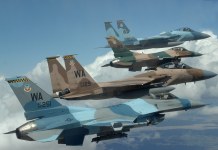With a focus on counterterrorism, India and the US have kicked-off the 16th edition of their joint military exercise, ‘Yudh Abhyas’, at the Mahajan Field Firing Ranges in Rajasthan’s Bikaner district bordering Pakistan. This is their third joint war drills in the past four months.
The 13-day exercise, which will conclude on February 21, is focusing on counterterrorism and promoting interoperability between the two forces, according to reports. The 11th Battalion of Jammu and Kashmir Rifles and the 2nd Battalion of the 3rd Infantry Regiment of 1-2 Stryker Brigade Combat Team of the US Army are participating in the wargames.
Chinooks in action during Ex #YudhAbhyas, an annual bilateral joint exercise between @adgpi and @USArmy, which commenced yesterday in the western sector. The Exercise aims to enhance cooperation and interoperability in Counter Terrorism ops.#FeatherWeights#IndianAirForce pic.twitter.com/OEp5pfRrR3
— Indian Air Force (@IAF_MCC) February 9, 2021
US soldiers checking out India’s #INSAS rifles during the ongoing India-US joint exercise #YudhAbhyas. pic.twitter.com/SV5ikL9r5T
— Saptak Mondal (@saptak__mondal) February 8, 2021
The India-US joint training Exercise 'YUDH ABHYAS' commenced at Mahajan Field Firing Ranges on 08 Feb 2021 with opening ceremony that saw unfurling of the National Flags of both countries amidst playing of the National anthems, “Jana Gana Mana” &“The STAR- SPANGLED BANNER”. pic.twitter.com/rh1iQNCr09
— PRO GUWAHATI, MINISTRY OF DEFENCE, GOVT OF INDIA (@prodefgau) February 8, 2021
The US Army contingent, comprising 270 soldiers, had arrived at Suratgarh, Rajasthan February 6. Almost the same number of soldiers from India are participating in the exercises.
Among the aerial platforms, newly-inducted Advance Light Helicopter WSI ‘RUDRA’, MI-17, Chinooks, Stryker Vehicles of the US Army, and BMP-II mechanized infantry combat vehicles of the Indian Army will be part of the drills.
India’s defense spokesperson Lt. Col. Amitabh Sharma has said that the exercise with the U.S. Army is significant in terms of security challenges faced by both nations in the backdrop of global terrorism.
Sharma said the joint military exercise will enhance the level of defense cooperation between the armies which will also foster the bilateral relations between both nations and reiterate India’s key role as a key partner in the Indo-Pacific region.
Yudh Abhyas series began in 2004 and is described by the US as “vital to effective and efficient peacekeeping and foreign disaster relief operations and civil affairs core tasks focused on humanitarian and disaster relief”.
"Brother on my left, brother on my right, together we train, together we fight." -Opening Ceremony Narration
Yudh Abhyas has officially commenced! The two-week bilateral exercise will build on the enduring Indian-U.S. military partnership in support of a #FreeAndOpenIndoPacific. pic.twitter.com/5Qx2qoXksA
— 1-2 Stryker Brigade Combat Team (@1SBCT_Ghost) February 9, 2021
As per reports, the US Embassy in New Delhi said that the format of the exercises will feature a command post exercise (CPX) and a field training exercise (FTX) along with expert academic exchanges and professional development workshops that focus on training at the corps-level and below.
Quoting an embassy statement, The Diplomat said the CPX will focus on United Nations-mandated peacekeeping missions, while the FTX will further “fundamental war-fighting skills to enhance combined operational capacity”.
The exercises indicate a steady growth in India-US relations and the continuation of the US’ Indo-Pacific policy with India at its helm. The two countries had participated in the Malabar naval drills along with Australia and Japan in November 2020. The four nations are part of the US-led Quadrilateral Security Dialogue or QUAD.
Both India and the US also participated in the anti-submarine Warfare Sea Dragon exercise in Guam last month — with Australia, Japan, and Canada being the other participants. The war drills have come at a time when India is locked in a border stand-off with China since May 2020.
Follow EurAsian Times on Google




